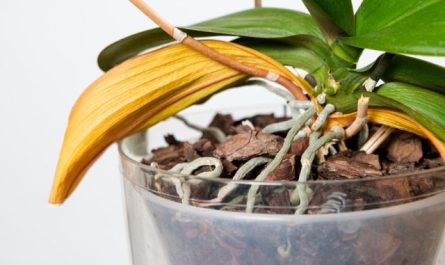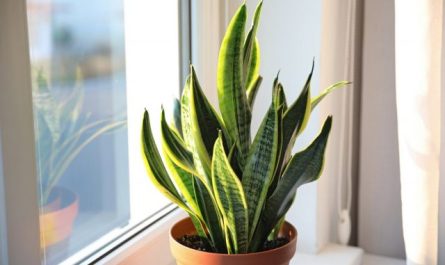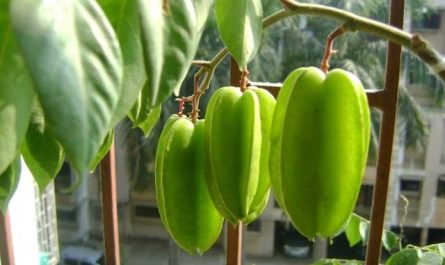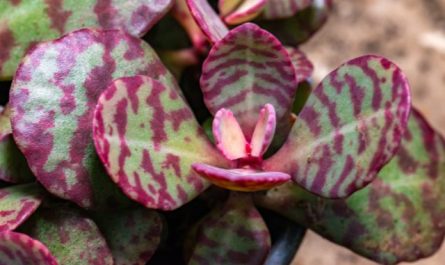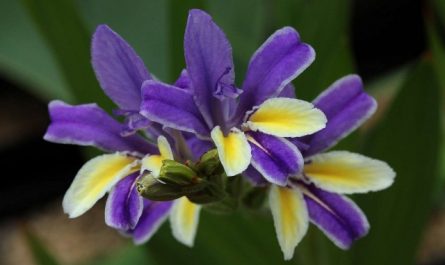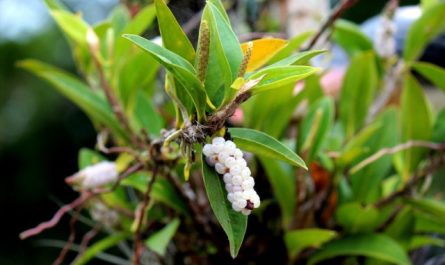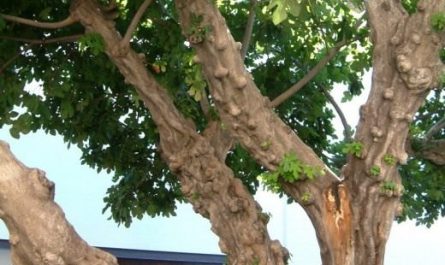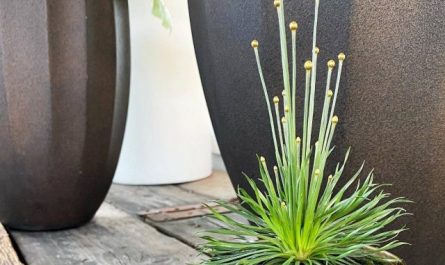“Mighty nature is full of wonders!” exclaims the elder Berendey from the spring fairy tale “Snegurochka” by A. N. Ostrovsky. One of such wonders is the active coexistence or, more precisely, the mutually necessary fellowship of plants and animals.
Many people seem to like the amber-colored cakes of dried figs. The fresh fruits, which fill the markets of our south at the end of summer and in autumn, are also very good and nutritious. Some, however, find them excessively sweet, but this, as they say, is a matter of taste.

© H. Zell
Fig is a small or medium-sized tree with a spreading crown and light-grey smooth bark. It is found in the wild or feral state in Transcaucasia, Crimea and Central Asia. It has large leaves, densely pubescent on the back, which on one tree can be whole or cut into lobes.
Fig inflorescences are unique. Their unusual appearance even fooled the patriarch of modern botanical taxonomy, Carl Linnaeus, who did not immediately manage to unravel their secret. The inflorescences, like the fruits of figs, or figs, as they are also called, are pear-shaped, with a hole on the flat top. Once in the Sukhumi Botanical Garden, the botanist Managadze led me to two trees that did not differ in appearance and asked me to guess which of them was male and which was female. No matter how much I tried to find the difference between the figs of purple shades, I could not do it. Then my companion plucked a fruit from each plant. Taking one of them with interest, I felt its fleshiness, and after biting into it, I was convinced that the fruit was like a bag with sweet, juicy, like ready-made jam, pulp. The second fig, outwardly the same, at the first touch turned out to be flabby, hollow. Its pliable skin left dents from fingers. It was worth tearing the skin of the fruit a little, and as if from a disturbed hive of bees, tiny insects tightly packed into it rushed to freedom. Only after such a visual lesson did Managadze tell me the riddle of the fig.
The male tree, it turned out, was a fig tree with flabby figs, and the female tree had juicy, edible fruits. It also turned out that this tricky riddle had been solved in ancient times, but its main essence was discovered later.

© pbyrley
Some trees are pollinated by the wind, others by a huge army of insects, and fertilization of figs can only be accomplished with the help of tiny black wasps, blastophaga, which carry pollen from male trees to female trees. Moreover, this wasp, in turn, cannot reproduce without the help of the fig.
The mechanism of such coexistence is very complex. Figs form three types of inflorescences. In one of them, developing at the end of September, the eggs and blastophagous larvae overwinter. Here in the spring, their new generation is born, feeds and mates. Subsequently, the females, whose bodies are abundantly sprinkled with pollen, begin to look for a place to lay eggs and try to populate the second type of inflorescence, from which the fig fruits develop. These inflorescences, however, are designed in such a way that wasps cannot lay eggs in them. While the wasp scurries around in the inflorescence, trying to settle in it, it manages to pollinate the female flowers, but lays eggs only in the third type of inflorescence, specially intended for this by nature. The new generation of females, emerging from these inflorescences at the beginning of autumn, in turn lays eggs, which overwinter in the flower house until spring.
So, in the pear-shaped inflorescences of the fig, its faithful allies, the blastophages, always find “both table and home.” They live, feed, reproduce, shelter their offspring from bad weather, and in gratitude for such care, conscientiously pollinate its flowers. Botanists call the process of pollination of flowers by blastophages caprification.

© Karen Apricot New Orleans
In the Caucasus and Crimea, you can hear several versions of the legend about how one merchant decided to get rich on figs. Here is one of them. Seeing that figs were in great demand, he bought a large fig garden. In the midst of the fruit harvest, a cunning, envious neighbor came to visit him. “Why do you keep these useless trees in the garden?” he asked the merchant, pointing to the male sterile figs. “I cut down mine a long time ago and planted good ones.” The guest left, and the merchant grabbed an axe and cut down the “useless” trees.
Winter passed, spring came, the harvest time came, but there was nothing to harvest. The fruits that appeared in the spring, hanging empty for a while, fell off. The same story repeated itself in the following years, until a foolish merchant who had gone bankrupt cut down the entire garden in a fit of anger.
However, scientists also got into trouble with figs. Following Linnaeus, the botanist Casparrini became famous for his new “discovery”, dividing one species of fig into two species: he assigned male specimens to one of them, and female specimens to the other. To the credit of the hapless botanist, he soon admitted his mistake.

© Ryan Somma
At one time, there were some would-be botanists who persistently discredited artificial caprification, a wise folk discovery, declaring it an illiterate undertaking. And caprification consisted of hanging caprifics (figs from male trees) strung on strings on female trees. This seemed to compensate for the lack of male fig trees and ensured better pollination of female flowers. The ancient Greeks were the first to collect caprifics. They knew how to preserve them at low temperatures, transported them in large quantities on boats between the Aegean Islands, and even traded them. The Greeks were the first to hang caprifics on female fig trees.
There were also some misunderstandings when the fig was brought to America. The naturalist Ezen, who brought the fig from Turkey to California, was booed by American farmers when he tried to convince them at a special meeting of the need to bring the fig along with its indispensable companion, the blastophaga wasp.
Be that as it may, the “tree with oddities” as a fruit plant has been known and respected since ancient times. It is believed that the cultivated form of fig comes from “Happy Arabia” – Yemen, from where it was borrowed by the ancient Phoenicians, Syrians, and then the Egyptians. Bas-reliefs with images of fig harvesting discovered by scientists testify to the ancient culture of figs in Egypt. These creations of ancient Egyptian masters were made more than 2500 years BC.

© Rounds
From Egypt, fig cultivation spread to the Aegean Islands, and from there (around the 9th century BC) to Hellas. It is interesting that the great philosopher Aristotle already knew about the existence of wasps accompanying figs (called psen), but their role was not fully known to him. He sort of guessed about their help to figs, believing that blastophages, penetrating into its unripe fruits, help preserve them on the tree.
In the southern regions of our country, figs have been cultivated since ancient times. In many regions of the Caucasus and Central Asia, its fruits are not only a delicacy, but also an important highly nutritious food. They contain up to 20 percent sugar, vitamin C, carotene, iron, calcium and other useful substances.
In the northern regions, figs are only delivered dried, as fresh ones easily spoil at the slightest damage and are therefore difficult to transport. Many delicious dishes are prepared from fresh figs: compote, marmalade, paste, jam.
Figs are not usually famous for their longevity; their trees rarely live more than 100 years, but in India there is a unique fig tree that is over 3000 years old.

© magbell
In Crimea, the Caucasus and Central Asia, figs easily run wild, settling on mountain screes, in crevices of stone blocks and on granite rocks devoid of any vegetation. The roots of this tree easily penetrate the hardest soil, penetrate the smallest cracks no worse than a steel drill, and gain a foothold in the most inaccessible places. In Adler, for example, two fig trees settled on the brick cornice of the local district executive committee, and a third even climbed the dome of an old church.
Fig culture is conquering new geographical areas, gradually moving further north. When cultivating it in cold zones, blastophaga, unfortunately, does not always follow it. It is very sensitive to heat and does not tolerate even the cold of the North Caucasus. In such cases, they resort to the services of fig, which does without its eternal companion. However, this type of fig (by the way, it is also suitable for indoor culture) loses the ability to produce seeds, it can only be propagated vegetatively – by green cuttings or layering.
It is curious that the wonderful fig tree is one of the close relatives of our indoor ficus and a distant relative of the mulberry tree – mulberry. Based on their relationship, scientists have spent a lot of work trying to cross the fig with a more frost-resistant mulberry. In California, Luther Burbank unsuccessfully struggled to implement this tempting idea. As often happens, a modest naturalist-experimenter from Crimea, Ya. I. Bomyk, managed to do it. In the harsh winter of 1949-1950 for Crimea, when frosts in Yalta reached 20 degrees and almost all the ordinary figs froze, Bomyk’s hardy hybrid survived. The lucky, hard-working naturalist places great hopes on his new fig-mulberry hybrid black Bomyk-4. It is still necessary to work long and persistently for the wonderful fig tree to take a new step towards the north.

© Fanghong
Author: S. I. Ivchenko
